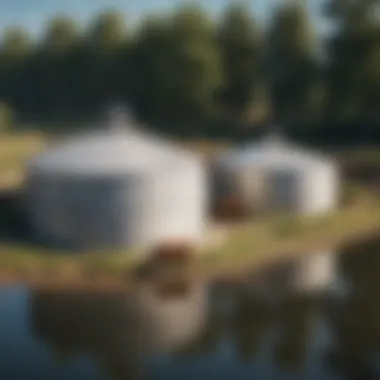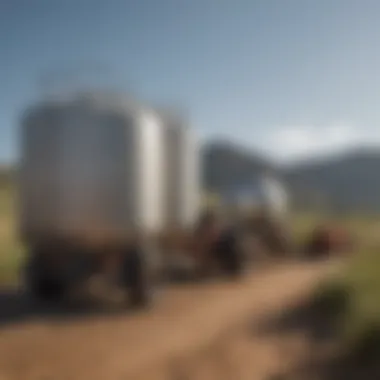Essential Insights on Livestock Water Tanks


Overview of the Topic
Definition and Importance
Livestock water tanks serve a vital purpose in the realm of agriculture. They provide a consistent and reliable water supply for various types of livestock, including cattle, sheep, and goats. Ensuring access to clean water is crucial for animal health, productivity, and overall welfare. Without adequate hydration, livestock can suffer from various health issues, including dehydration and reduced milk or meat production. Water tanks are not merely containers; they are critical components of agricultural infrastructure that directly influence the success of livestock farming.
Current Trends
The landscape of livestock water management has seen significant shifts in recent years, driven by a growing emphasis on sustainability and efficiency. Farmers are increasingly adopting technology to monitor water levels and quality, integrating smart sensors and automated systems into their operations. This trend not only enhances efficiency but also protects environmental resources by reducing waste. Additionally, the materials and design of water tanks are evolving as producers seek to minimize their ecological footprint and ensure longevity.
Key Techniques and Practices
Step-by-Step Guide
- Assessing Needs: Begin by evaluating the specific needs of your livestock. Consider factors such as the number of animals, their water consumption rates, and the climate of your region. Understanding these aspects will help determine the type and size of the water tank required.
- Selecting the Right Tank: Choose a tank made from suitable materials, such as concrete, plastic, or steel. Each material has distinct advantages; for instance, concrete offers durability, while plastic is often lighter and easier to install.
- Location and Setup: Position the tank strategically to ensure easy access for livestock and maintenance personnel. Proper installation helps prevent contamination and protects against environmental factors like extreme weather.
- Routine Maintenance: Establish a maintenance schedule. Regular checks for leaks, cleaning of the tank, and inspection of water quality are essential to ensure that the animals have a safe and reliable water source.
Tools and Equipment Needed
- Water Quality Test Kits: To monitor the cleanliness and safety of the water.
- Cleaning Supplies: Brushes, scrapers, and cleaning agents are necessary for regular maintenance.
- Pumps and Filtration Systems: These can enhance the quality and availability of water, especially in larger setups.
- Pressure Gauges: Useful for monitoring water levels within the tank to prevent overflow and ensure proper supply.
Challenges and Solutions
Common Obstacles
Managing water supply systems for livestock can present several challenges. These include:
- Seasonal Variability: Weather changes can lead to fluctuating water levels, affecting availability.
- Contamination: External pollutants can compromise water quality, posing health risks to livestock.
- Infrastructure Damage: Tanks can suffer from wear over time, leading to leaks and inefficiency.
Innovative Solutions
To combat these challenges, farmers are exploring innovative solutions. For instance, rainwater harvesting systems can supplement water supply during dry periods. Communities are increasingly turning to water treatment solutions to ensure purity. Advanced monitoring systems that utilize IoT technology can alert farmers about potential issues in real time, enabling quick responses to emerging problems.
"Ensuring a consistent and clean water supply is not just about the health of livestock; it is about the sustainability of the farming operation itself."
Prologue to Livestock Water Tanks
Livestock water tanks are a critical component of agricultural operations, influencing both livestock health and productivity. Understanding their significance goes beyond mere functionality; it is about recognizing how these water sources contribute to the overall efficiency of farm management. Access to fresh water is vital for livestock, impacting their growth, milk production, and reproductive performance. Thus, proper management of water resources is essential for any farmer.
Definition and Importance
Livestock water tanks can be defined as structures designed to store water, providing a reliable supply for animals in various farming environments. Their importance lies in their role as a water source, especially in regions where natural water bodies are scarce. These tanks can be made from diverse materials including steel, plastic, and concrete. Each type has its own advantages and drawbacks.
The significance of livestock water tanks extends to several benefits:
- Health of Livestock: Animals require clean water daily; this is fundamental for their well-being and growth.
- System Efficiency: Well-planned water storage reduces the time and labor needed to supply water to livestock, thus increasing farm productivity.
- Sustainability: Water tanks allow the collection and storage of rainwater, promoting sustainable practices in water management.
In summary, understanding the definition and importance of livestock water tanks is essential for anyone involved in agricultural activities. Their role is not just logistical; they are integral to the health of livestock and ultimately, the success of farming.
Historical Context
The concept of livestock water tanks has evolved over centuries. Historically, farmers relied on natural water sources like rivers and ponds. However, these sources were not always reliable, leading to the need for more structured solutions.
The shift towards man-made tanks began in the late 19th century when agricultural innovations took hold. Early tanks were often rudimentary, made from local materials. Over time, developments in material science and engineering led to the creation of more durable and efficient tanks. Modern tanks can be found in various forms, adapted to the needs of different farming practices.
In contemporary agriculture, the evolution of livestock water tanks reflects broader changes in farming techniques. New materials offer better insulation and longevity, sculpting the landscape of water management.
As we explore further, we will analyze the different types of livestock water tanks and their specific applications in farming.
Types of Livestock Water Tanks
Understanding the various types of livestock water tanks is essential for effective agricultural practices. The choice of tank directly impacts the accessibility and quality of water available to livestock. Selecting the wrong type can lead to inefficiencies, increased labor, and even health issues among animals. Here, we will explore the three primary types: Above-Ground Tanks, In-Ground Tanks, and Portable Water Tanks. Each type has distinct advantages and challenges that are crucial to consider based on the specific needs of the farm.
Above-Ground Tanks
Above-Ground Tanks are often chosen for their versatility and ease of installation. These tanks come in various sizes, making them suitable for both small and large operations. Typically made from materials such as polyethylene, steel, or fiberglass, they offer durability and resistance to corrosion.
Some key benefits of Above-Ground Tanks include:
- Accessibility: Since these tanks are elevated, they provide easy access for both filling and cleaning.
- Visibility: Monitoring water levels is simpler, helping farmers react promptly if levels fall too low.
- Temperature Control: The exposed nature of these tanks can aid in maintaining a consistent water temperature, which is essential for livestock.
However, they are not without their drawbacks. Vulnerability to extreme weather, such as freezing temperatures, can affect their performance. Additionally, these tanks often require more maintenance compared to in-ground options.
In-Ground Tanks
In-Ground Tanks are a popular choice for many farmers because they minimize the impact of environmental conditions on water quality. Being underground, they are less susceptible to temperature fluctuations, which can benefit livestock health.
Benefits of In-Ground Tanks include:
- Protection from Elements: The underground placement offers protection from UV rays and extreme temperatures that can lead to algae growth and water contamination.
- Space Efficiency: These tanks do not take up valuable surface area, allowing for more useable space for farming activities.
- Durability: In-ground tanks are often constructed from concrete or reinforced materials, providing long-term strength and stability.
Nonetheless, they require careful site selection and construction to avoid problems like groundwater contamination. The initial installation costs can also be higher due to the need for excavation and proper placement.
Portable Water Tanks
Portable Water Tanks provide an innovative solution for dynamic farming environments. These tanks are lightweight and can be moved to different locations as needed. They are especially useful for rotational grazing practices, where livestock are shifted across various pastures.
Some advantages of Portable Water Tanks include:
- Flexibility: They can easily be relocated, ensuring livestock always have access to fresh water.
- Cost-Effective: Relatively low in initial investment and maintenance, making them suitable for small and medium-sized operations.
- Ideal for Temporary Storage: These tanks can serve well for seasonal livestock or in areas where water supply is not consistent.


On the downside, their lower capacity can lead to frequent refilling, especially in larger herds. Additionally, they often lack the insulation benefits of larger, fixed tanks, making water quality management more challenging in extreme weather conditions.
In summary, identifying the right type of tank is vital for livestock management. Each tank type—above-ground, in-ground, or portable—holds distinct advantages and considerations that can greatly affect agricultural productivity and animal welfare. Proper evaluation of the unique needs of your farm will guide you toward the most appropriate choice.
Selecting the Right Tank
Choosing the right livestock water tank is fundamental for any agricultural operation. An appropriate tank ensures that animals have constant access to fresh water, which is crucial for their health and productivity. An informed selection can also lead to reduced maintenance costs and enhanced operational efficiency.
Essential elements to consider include size, material, and cost. Each of these factors plays a critical role in determining the overall effectiveness of a water supply system. Moreover, understanding livestock needs must align with tank selection to promote welfare and productivity.
Factors to Consider
Size and Capacity
The size and capacity of a tank directly impact its ability to meet livestock hydration needs. A larger tank can store more water, thus reducing the frequency of refills. This is particularly beneficial for farms with multiple animals or during hot seasons when water consumption increases.
Key characteristic: Large capacity tanks are often capable of accommodating greater water usage, ensuring uninterrupted supply.
Unique feature: A tank with adjustable capacity allows for flexibility depending on seasonal requirements. However, larger tanks can be more expensive and may require more space than smaller options. Thus, a balanced decision on size is crucial for optimal resource management.
Material Choices
Material choice is another vital consideration. Common materials include plastic, metal, and concrete. Each has its own set of advantages and disadvantages.
Key characteristic: Plastic tanks are lightweight and resistant to corrosion, making them easy to install and maintain.
Unique feature: Metal tanks may provide greater durability and strength, but they often require more maintenance to prevent rust over time. Conversely, concrete tanks can be sturdy and have excellent insulation properties, yet they are costly and labor-intensive to install. Selecting the right material impacts not only the initial investment but also longevity and maintenance aspects.
Cost Considerations
Cost plays a significant role in tank selection. It encompasses the initial purchase price and ongoing maintenance expenses. A comprehensive cost analysis is essential.
Key characteristic: Selecting a tank that fits within budget can prevent financial strain on agricultural operations.
Unique feature: Low-cost options may seem attractive initially. However, their longevity and durability must be evaluated to avoid future expenses from damages or replacements. Investing in a higher-quality tank may yield better long-term savings by reducing maintenance and replacement frequency.
Assessing Livestock Needs
Assessing the specific needs of livestock is paramount when selecting a water tank. Different species have varying water consumption levels, influenced by factors like size, age, and environmental conditions.
Determining the required water availability involves observing livestock behavior and understanding their habits. Engaging with local agricultural experts can also provide insight to help tailor the tank size and type to livestock needs. Importantly, access to water must be easy for all animals to maintain health and productivity.
Tank Design and Construction
Tank design and construction are critical factors in ensuring that water supply systems effectively serve livestock needs. A well-designed tank can safeguard water quality and promote efficient resource usage, thus aiding overall livestock productivity. Conversely, poor design may lead to contamination and excessive maintenance problems, ultimately affecting a farm’s output.
Engineering Principles
The engineering principles involved in tank design encompass several aspects, including structural integrity, capacity, and accessibility. Structural integrity ensures that the tank can withstand local weather conditions and avoid physical deterioration. Tanks should be built with materials that resist corrosion and the growth of microorganisms.
Common materials used are plastic, fiberglass, and concrete. Each material comes with its own benefits and drawbacks regarding durability, cost, and ease of maintenance.
Capacity is another vital element to consider. The tank must hold enough water to meet the needs of the livestock throughout the day. Farmers should consider the number of animals and their water intake. Larger herds typically require bigger tanks or multiple tanks to distribute water efficiently.
Accessibility also plays a role in design. Utility must be balanced with placement, allowing for easy access for both livestock and maintenance personnel. Tanks should avoid remote locations that are difficult to reach, especially in emergencies.
Environmental Considerations
Environmental factors must also influence the design and location of water tanks. Tanks should be placed where they are less likely to contaminate surrounding soil and waterways. For example, tanks should be situated away from areas prone to flooding or erosion.
In addition, using Sustainable design practices can minimize the negative ecological impact. For instance, considering runoff control systems can help prevent water pollution. More farmers today are looking at using rainwater harvesting systems integrated with water tanks to improve water availability while preserving environmental resources.
Ensuring proper tank design is not just about functionality. It significantly impacts environmental sustainability as well.
Ultimately, understanding these engineering principles and environmental considerations can lead to better livestock water management strategies. By getting these aspects right, farmers can contribute to higher animal welfare and better sustainability, fostering a healthier agricultural environment.
Maintenance of Water Tanks
Maintenance of water tanks is a critical area in ensuring the long-term functionality and reliability of these systems. Regular maintenance not only preserves the structural integrity of the tanks but also guarantees the quality of water supplied to livestock. Untended water tanks can lead to serious health risks for animals and create operational inefficiencies on a farm. Thus, establishing a systematic approach to maintenance can improve productivity while promoting better animal welfare.
Routine Maintenance Practices
Routine maintenance practices for livestock water tanks are essential to keep them in optimal condition. These practices include:
- Cleaning: Regular cleaning helps in removing debris and preventing algae buildup. This should be done monthly or more frequently in warmer conditions where algae thrive.
- Inspections: Conduct thorough inspections every few months to identify any signs of damage, corrosion, or wear. This proactive method allows for timely repairs.
- Repairs: Address minor repairs immediately. Patching small cracks or leaks can save resources before they escalate into bigger problems.
By staying vigilant and adopting these maintenance practices, farmers can ensure their water tanks remain serviceable and safe.
Common Issues and Solutions
Leaks
Leaks can severely impact the efficiency of livestock water tanks. They may cause water loss and increase operational costs. Identifying leaks early can significantly minimize these issues. The key characteristic of leaks is their potential to escalate if not addressed promptly. In this article, we emphasize monitoring for signs of leakage through regular inspections. A unique feature of leaks is that they are often caused by structural weaknesses or external impacts. Addressing them early leads to cost savings and uninterrupted water supply for livestock.
Algae Growth
Algae growth is a common issue in water tanks. It can lead to reduced water quality, making it harmful for livestock. Algae thrive in warm, nutrient-rich conditions, which can be facilitated by standing water. The critical characteristics of algae growth include rapid proliferation under favorable conditions. Understanding its development can help in implementing preventive measures.
Unique to algae growth is its visible nature, making tanks appear unclean. Regular cleaning and proper tank coverage are effective solutions to manage this issue. These practices prevent algae from thriving and ensure livestock consume clean water.


Contaminants
Contaminants can enter water tanks from various sources, including runoff, debris, or poor tank construction. These contaminants can jeopardize the health of livestock by causing illnesses. The key characteristic of contaminants varies widely, encompassing chemical, biological, and physical impurities.
Management of contaminants is essential for maintaining water quality. Implementing filtration systems and ensuring proper tank placement away from potential sources of contamination can effectively mitigate risks. In summary, understanding these common issues allows farmers to adopt preventive and corrective measures, ensuring a sustainable water supply for their livestock.
Water Quality Management
Water quality management is a crucial aspect of maintaining livestock water tanks. This area ensures that the water supplied to livestock is safe, clean, and suitable for drinking. Proper management of water quality can significantly enhance the overall health of livestock. Healthy animals lead to better growth rates, increased milk and meat production, and reduced veterinary costs. Ensuring high-quality water fosters an environment where livestock can thrive and supports sustainable agricultural practices.
Testing Water Quality
Testing water quality is the first step in effective water management. Regularly assessing the water in livestock tanks is essential to identify potential hazards. Different tests can reveal the presence of harmful bacteria, heavy metals, and other contaminants. Here are some key elements to consider when testing water quality:
- Microbial Contaminants: These include bacteria, viruses, and protozoa. Tests can indicate the presence of pathogens that might affect livestock.
- Chemical Analysis: This examines pollutants like nitrates, ammonia, and sulfates, which can contribute to health issues in livestock.
- Physical Properties: Observations about turbidity or sediment deposits can provide a quick insight into the water's cleanliness.
Conducting tests every few months or immediately after significant weather events helps to maintain consistent quality. It also allows careful monitoring during hot months or periods of heavy rainfall, when contamination risks may increase.
Maintaining Optimal Water Conditions
Maintaining optimal water conditions is about more than just cleanliness; it encompasses temperature control, pH balance, and overall system hygiene. Livestock are sensitive to changes in their water supply, so stable conditions are key. Here are some critical considerations:
- Temperature Control: Water that is too hot or too cold can affect livestock's willingness to drink and their overall health. Insulating tanks or using heaters in winter can help in this regard.
- pH Levels: The water's acidity can impact mineral availability and microbial life. Ideally, water should have a neutral pH. Testing and adjusting as needed is essential.
- System Hygiene: Regular cleaning of tanks and associated plumbing helps prevent algae growth and sediment buildup. Systematic maintenance can address leaks, which are often overlooked yet can cause significant loss of quality.
By integrating effective testing and maintenance strategies, farmers can ensure that livestock receive the best quality water possible, thus enhancing productivity and welfare.
"Clean water is not just a necessity; it is a foundation for healthy livestock and sustainable agriculture."
For more information on managing water quality, consider visiting Wikipedia or Britannica.
Environmental Impact of Water Tanks
The environmental impact of livestock water tanks is a critical dimension of their implementation that deserves thorough exploration. Water tanks, while essential for the sustenance and well-being of livestock, also bear responsibilities towards the environment. Understanding these impacts requires examining specific elements such as resource utilization, availability of water, and the overall effect on local ecosystems.
Water tanks influence not only livestock health but also the surrounding wildlife and plant life. Ensuring a sustainable approach to the design and usage of these tanks can mitigate adverse effects. It also plays a vital role in preserving natural water resources while supplying needs effectively.
Sustainable Practices
Sustainable practices in managing livestock water tanks include methods that aim to minimize the environmental footprint. Here are key strategies:
- Rainwater Harvesting: This practice involves collecting and storing rainwater for livestock usage. It reduces dependence on traditional water sources and promotes ecological balance.
- Efficient Water Use: Employing water-saving technology helps ensure that water is not wasted. Techniques such as drip irrigation and automated valves can contribute significantly to this efficiency.
- Using Recycled Water: In some cases, treated wastewater can be repurposed for livestock watering. This approach conserves fresh water while adhering to safety measures.
- Proper Tank Location: Placing tanks away from environmentally sensitive areas such as wetlands or streams helps protect these ecosystems.
Implementing these sustainable practices can foster a more responsible relationship between livestock management and environmental stewardship.
Addressing Ecological Concerns
Ecological concerns related to livestock water tanks encompass a range of issues from habitat disruption to water contamination. Key areas to address include:
- Water Quality: Contaminated water sources pose serious health risks to livestock and humans. Regular testing is paramount to ensure quality.
- Invasive Species Control: Water tanks can inadvertently become breeding grounds for invasive species. Proper management and monitoring are essential to prevent their introduction.
- Impact on Biodiversity: The presence of livestock water tanks can alter local biodiversity. It is crucial to assess the diversity of flora and fauna around these installations and manage changes accordingly.
- Soil Erosion Control: Tank installation can lead to soil erosion. Implementing erosion control measures is necessary to maintain the integrity of the land around the tanks.
By proactively addressing these ecological concerns, one can create an effective balance between agriculture and environmental health. This dual focus not only supports livestock productivity but also underscores the importance of ecological preservation in agricultural systems.
Integrating Technology in Water Management
The integration of technology in water management for livestock is increasingly essential. As agricultural practices evolve, the need for efficient and effective water supply systems has become apparent. Technology enhances water management through improved efficiency, reduced waste, and better monitoring of resources. Thus, adopting innovative technologies can significantly affect livestock productivity and welfare.
Smart Water Systems
Smart water systems are designed to optimize the use of water resources in livestock management. These systems incorporate various technologies, such as sensors and automated controls, that play a crucial role in monitoring water levels and quality. Here are some benefits of smart water systems:
- Real-Time Monitoring: Sensors provide immediate data on water quality and usage, helping farmers to make informed decisions quickly.
- Automation: Automated valves and pumps can manage water delivery based on real-time data, removing the need for constant manual oversight.
- Alert Systems: These systems can send alerts regarding low water levels or contamination, allowing for prompt response.
The implementation of smart water systems ensures optimal management of available resources. It allows farmers to adjust their strategies based on data gathered, ultimately leading to improved operational efficiency.
"Investing in smart technologies for water management can lead to significant long-term savings and productivity improvements in livestock operations."
Monitoring Water Usage
Effective monitoring of water usage is essential for sustainable livestock farming. By keeping track of water consumption, farmers can identify patterns and areas where adjustments are necessary. This contributes not only to conservation efforts but also enhances the overall health of livestock.
Key aspects of monitoring water usage include:
- Data Analysis: Analyzing historical water usage data helps in forecasting future needs. This way, farmers can plan accordingly, avoiding shortages during critical times.
- Usage Tracking: Employing metering systems enables accurate tracking of water usage across different tanks or locations, aiding in resource allocation.
- Identifying Inefficiencies: Continuous monitoring allows for the identification of leaks or other inefficiencies, ensuring that water is not wasted.
Overall, monitoring water usage is not just about conservation; it also plays a part in optimizing livestock health and farm productivity, making it an integral aspect of modern agricultural practices.
Economic Implications of Water Management
Water management is a pivotal element in the agricultural sector. Understanding the economic implications related to livestock water tanks can provide farmers with insight into their investment decisions and operational efficiency. This section will examine specific elements such as cost-benefit analysis and the importance of investing in infrastructure.
Cost-Benefit Analysis
A thorough cost-benefit analysis is crucial for farmers when selecting livestock water tanks. This approach assesses the feasibility and economic value of the investment by comparing the costs incurred with the anticipated benefits. Common costs include purchasing the tank, installation, maintenance, and operation expenses. It can also involve indirect costs, such as potential losses from livestock not receiving adequate water.
On the benefits side, increased productivity is key. Livestock that have constant access to clean water tend to exhibit improved health, which affects weight gain and milk production. Additionally, farmers can factor in long-term savings on water bills or infrastructure repair costs when evaluating tank choices.
The analysis may also include environmental savings, such as reduced runoff and contamination costs which can arise from improperly managed water systems. By understanding these financial variables, farmers can make empowered decisions that optimize both their yield and profitability.
Investment in Infrastructure


Investing in water management infrastructure is often seen as a long-term strategy, yet its immediate benefits can be significant. Establishing high-quality, reliable water tanks not only ensures a consistent supply but also adds value to the entire farming operation. Proper infrastructure can lead to lower operation costs and less downtime during critical growing seasons.
Farmers should consider the following elements for investment:
- Durability: Selecting materials that withstand environmental stresses ensures longevity.
- Capacity: Sizing the tank appropriately can accommodate fluctuations in water demand during hotter months.
- Technology Integration: Using technology like sensors or smart monitoring systems can bring a return on investment through efficient water use.
Investment in livestock water tanks is not merely about purchasing equipment; it's a strategy that promotes sustainable farming and operational resilience.
Overall, understanding the economic implications of water management allows farmers to mitigate risks while enhancing productivity. The insights gained from careful planning and investment decisions can shape the future of their operations, fostering a more efficient and sustainable agricultural landscape.
Case Studies
Case studies serve as an essential element in understanding the practical implications of livestock water tank management. They provide real-world examples that demonstrate the challenges and successes faced by farmers. Analyzing these scenarios, one can discern effective practices while evaluating pitfalls that others have encountered. This section not only highlights the various approaches taken but also showcases the results of specific implementations.
Successful Implementations
Successful implementations of livestock water tanks can reveal valuable insights for agricultural stakeholders. For instance, a dairy farm in Wisconsin adopted automated water management systems, linking their water tanks to smart technology. By monitoring water levels and quality remotely, they minimized waste and ensured optimal conditions. Their cattle showed improved hydration, which correlated with increased milk production.
Another example is a ranch in Texas that converted to a combination of in-ground and above-ground water tanks. The dual-system allowed for flexibility based on weather patterns. During dry spells, the ranchers relied more on above-ground tanks, which were easier to refill. The conservation of water during such periods not only helped the livestock but also contributed positively to the overall sustainability of the operation.
Lessons Learned
Through these case studies, several key lessons emerge. Firstly, the importance of understanding local climate conditions cannot be overstated. Tanks should be designed or selected based on geographical and seasonal factors. In regions with heavy rainfall, securing tanks from overflow and erosion becomes critical.
Secondly, investment in regular maintenance is paramount. Farmers who skimp on maintenance often find themselves facing significant issues later. For instance, algae growth has been a prevalent problem in some case studies, leading to health risks for livestock. Regular cleaning schedules and installation of filtration systems proved effective in addressing these concerns.
Lastly, engaging with the community can yield unexpected benefits. Networking with other farmers revealed new ideas and solutions that had not been considered previously. Collaboration fosters an exchange of practical knowledge, enabling farmers to learn from each other's experiences.
"Real-life cases highlight the intersection of theory and practice in livestock management. By observing others, we can map our paths more effectively."
The empirical evidence drawn from these case studies emphasizes that tailored water tank solutions not only enhance productivity but also promote a more sustainable agricultural landscape.
Regulations and Compliance
In the realm of livestock water management, regulations and compliance play an essential role. They ensure that water tanks not only meet the functional needs of livestock but also adhere to safety and environmental standards. The implications of these regulations extend beyond mere legal obligations; they significantly influence the well-being of livestock and the sustainability of agricultural practices.
Regulatory frameworks often evolve to accommodate new scientific insights and environmental challenges. Understanding these regulations is vital for farmers and stakeholders. Non-compliance can lead to fines, operational disruptions, and potentially negative impacts on animal health and productivity.
Understanding Local Regulations
Local regulations are often shaped by regional water availability, climate conditions, and specific agricultural practices. Each area may have distinct laws governing water usage, storage, and quality. Farmers must familiarize themselves with these regulations to avoid conflicts with local authorities.
Key aspects of local regulations may include:
- Permitting requirements for constructing and maintaining water tanks
- Water quality standards ensuring that the water is safe for livestock consumption
- Environmental impact assessments that evaluate how water management practices affect surrounding ecosystems
The process of understanding local regulations can often be complex, involving county or state agricultural departments. Engaging with these entities can provide valuable insights and guidance.
Best Practices for Compliance
To achieve compliance with local regulations, farmers should adopt several best practices. These practices can facilitate smoother operations while ensuring adherence to the established standards.
- Conduct Regular Audits: Assess the water tanks and systems in use against local regulations to identify areas that may need attention.
- Stay Informed: Keep abreast of any changes in regulatory standards. Subscribing to local agricultural newsletters or attending workshops can be beneficial.
- Documentation: Maintain thorough records of water quality tests, maintenance schedules, and compliance audits. Documentation serves as proof of compliance during inspections.
- Engage with Experts: Consult with agricultural extension agents or legal advisors familiar with local laws to ensure compliance.
- Community Involvement: Engage in community forums or agricultural groups where discussions on regulations occur. This can aid in sharing insights and best practices within the community.
"Compliance is not just a box to check; it is an ongoing commitment to sustainability and public health."
By following these best practices, farmers will not only adhere to regulations but also contribute to the greater good of sustainable agriculture. A proactive approach to compliance can also enhance the image of the agricultural sector, promoting best practices for water management.
Future Trends in Livestock Water Management
Understanding the future trends in livestock water management is crucial for farmers today. With increasing pressures from climate change and growing populations, the way we manage water resources for livestock must evolve. There are several innovative approaches and technologies that have emerged to address these challenges. These trends not only promise improved efficiency and productivity but also emphasize sustainability and eco-friendliness in agricultural practices.
Innovative Approaches
New technologies are transforming how livestock water management operates. Farmers can now utilize smart irrigation systems, which integrate sensors and automated controls to optimize water usage. These systems allow for precise water application, reducing waste and ensuring that livestock have access to clean and sufficient water supply.
Another innovative approach includes the use of rainwater harvesting systems. This technique captures and stores rainwater, providing a sustainable source of water for livestock. It reduces reliance on ground or surface water, making it a valuable practice, especially in regions facing water scarcity.
Additionally, advanced water purification technologies help maintain water quality by treating and filtering water in real-time. This innovation minimizes the risk of contamination and supports the health of the livestock. Adopting these forward-thinking methods can provide farmers with more reliable water resources.
Impact of Climate Change
Climate change is increasingly impacting water supply in agriculture. As temperatures rise and weather patterns shift, the availability of fresh water is becoming unpredictable. Farmers need to adapt their water management strategies to mitigate these challenges. It is essential to consider changing rainfall patterns, which can lead to either droughts or excessive rainfall. This variability can dramatically affect livestock health and productivity.
Farmers may also need to adopt more resilient water storage solutions. For example, designing tanks that can withstand extreme weather conditions helps secure water supply. Investing in infrastructure that accommodates these changes is vital to ensure livestock welfare.
"Adaptability is crucial in the face of climate change. Livestock water management must evolve to meet new challenges and ensure sustainability."
To sum up, understanding the future trends in livestock water management is essential for maintaining high levels of productivity and sustainability in agriculture. Innovative approaches and the recognition of climate challenges will help farmers develop better strategies to secure water resources efficiently.
Closure and Recommendations
In this article, we have explored various critical dimensions of livestock water tanks, underlining their significance in effective agricultural practice. The conclusion and recommendations segment encapsulates the essential learnings from the discussion, reaffirming the role these tanks play in livestock welfare and productivity. The ongoing management and maintenance of water supply systems directly affect livestock health, which in turn impacts overall farm yield and profitability. As water management is placed at the heart of agricultural operations, a well-thought-out conclusion speaks to how vital it is to harmonize technology and sustainability in this domain.
The recommendations aim to provide practical insights that can be implemented by farmers. Understanding specific practices such as regular water testing, optimal tank placement, and diligent maintenance can yield substantial benefits. Farmers are encouraged to reflect on their current water management systems and consider necessary enhancements or adaptations to improve overall functionality.
Summarizing Key Points
- Importance of Water Tanks: Water tanks are indispensable for sustaining livestock well-being and enhancing productivity. Proper hydration is fundamental for maintaining healthy animals and facilitating optimal growth.
- Types of Water Tanks: The diversity of tank options—from above-ground to portable tanks—means that farmers have choices aligned with their specific needs. Each type provides unique benefits and limitations worth assessing based on livestock requirements.
- Selecting the Right Tank: Elements such as size, material, and cost should guide the decision-making in selecting a tank. Understanding the specific needs of livestock is crucial in this process.
- Maintenance and Quality Management: Regular maintenance is essential in prolonging the lifespan of water tanks and ensuring water quality. Routine checks for leaks, debris, and contaminants are essential practices that enhance water safety for livestock.
- Environmental and Economic Impact: Sustainable and economically viable water management practices can lead to both ecological benefits and improved profitability for farmers, reinforcing the idea that environmental consciousness and business acumen can coexist beneficially.
Practical Steps for Farmers
- Assess Livestock Water Needs: Begin with understanding how much water your livestock requires. This will inform the size and number of tanks needed.
- Regular Testing of Water Quality: Schedule routine assessments to test for pathogens, chemical contaminants, and overall water quality to ensure livestock health.
- Implement Maintenance Checklist: Create a checklist for maintenance tasks. Check tanks periodically for leaks, cleaning, and fulfilling repair needs.
- Optimize Tank Location: Ensure that tanks are positioned in shaded areas when possible, which can help to maintain cooler water temperatures and reduce evaporation.
- Explore Technological Solutions: Consider integrating smart water management systems that monitor usage and quality, providing timely alerts for any issues.
- Educational Resources: Stay informed about changing regulations and best practices through reliable agricultural resources like Wikipedia, Britannica, and community forums such as Reddit.
These steps are practical avenues for farmers to enhance their water management systems while realizing the interconnection between sustainable practices and livestock productivity.



